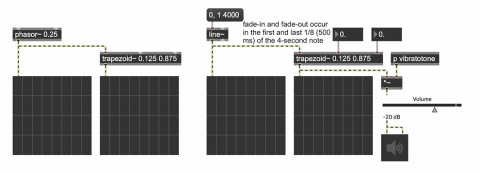Trapezoidal control signals

The trapezoid~ object outputs a trapezoidal shape, rising linearly from 0 to 1 in a certain fraction of its time, then staying at 1, then falling linearly back to 0 in a fraction of its time. Its timing is driven by a control signal at its input, one that goes in a straight line from 0 to 1; so a phasor~ or a line~ is the obvious choice for input to trapezoid~. As the input goes from 0 to 1, the output draws the designated trapezoidal shape. (Thus, the ramp times, which are specified as a fraction of the whole period, depend on the timing of the input.)
A trapezoid is often used as an amplitude "window", to create a fade-in at the beginning and a fade-out at the end.
In this example, line~ and trapezoid~ are used to make a 4-second amplitude envelope for a tone. Because the whole envelope is four seconds long, the fade-in and fade-out are each 1/8 of that—500 ms.